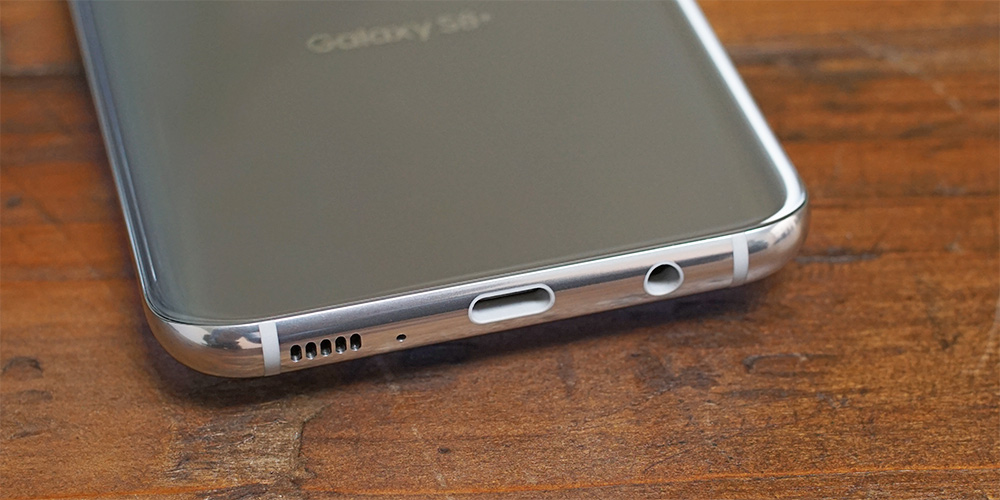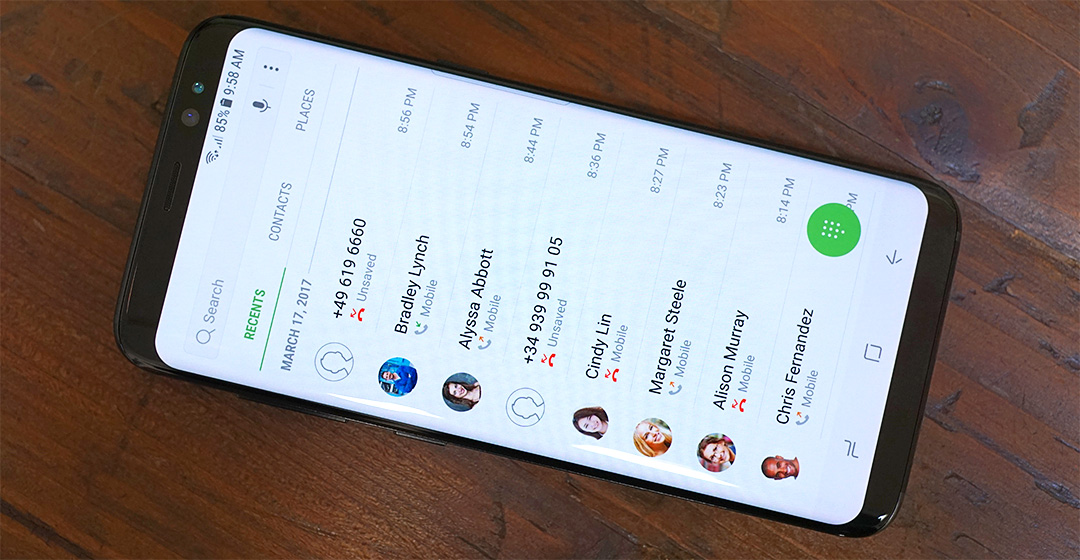Hands On With Samsung's Galaxy S8 and S8+: Taller Screens and Slimmer Bezels
by Matt Humrick on March 29, 2017 11:00 AM EST- Posted in
- Smartphones
- Samsung
- Galaxy
- Mobile
- Galaxy S8

Samsung officially unveiled the latest Galaxy devices at its Unpacked event in New York today. Previous Galaxy phones were part Porsche 911 Carrera, with an easily recognizable curvaceous style, and part Swiss Army knife, bristling with technology and features. This analogy holds true for the 5.8-inch Galaxy S8 and 6.2-inch Galaxy S8+, which share the same design DNA as the previous two generations.
The new phones’ aluminum frame remains sandwiched between edge-to-edge Corning Gorilla Glass 5, with curved sides on the front and back. The curved rear glass makes the phones easier to pick up and more comfortable to hold just as they did for the S7 and S7 edge, while the curved front glass—now standard on both S8 models—adds some visual flair.
There’s not much difference between the S8 and S7 along the sides either. The USB Type-C port on the bottom is flanked by a 3.5mm headphone jack and a single downward-firing speaker. The microSD/NanoSIM combo tray still resides on the top, and the thin power button is still a bit more than halfway up the right side. The only differences between new and old lie on the left side, where the volume buttons have been combined into a single rocker and a dedicated button for launching Samsung’s Bixby assistant makes its debut. Unlike the power button, I found myself occasionally pressing the Bixby button accidentally when picking up the smaller S8.
The most significant change is found up front, however, and it’s one that impacts both form and function. The Galaxy S8 and S8+ adopt Samsung’s new “Infinity Display” that stretches the screen vertically but not horizontally, deviating from the traditional 16:9 aspect ratio. The result is a QHD+ SAMOLED display with a 2960x1440 resolution and an 18.5:9 aspect ratio that’s very similar to the 18:9 aspect ratio display LG is using in its G6. Both Samsung and LG cite market research for this new display direction: People want larger screens that can show more content, but they also want phones that are useable with one hand and can fit in their pocket. The taller screen fits more content, so less scrolling, but keeps the phone narrow, so it’s easier to wrap your hand around.
Both S8 phones incorporate another emerging design trend: rounded display corners. Where LG’s G6 is using an LCD panel that actually has rounded corners, it appears Samsung is using a rounded bezel to cover the S8’s still sharp-cornered display. This avoids the aliasing that’s evident in the G6’s corners, producing a much smoother, nicer looking effect. While my time with the S8 was limited, it appears that TouchWiz and Samsung’s apps were redesigned to account for the rounded corners: Backgrounds extend the full height of the display and visual elements are still displayed along the top and bottom edges without getting cut off. Third-party apps, however, find their vertical dimensions constrained to the purely rectangular portion of the display, with the status bar above and the navigation bar below taking on black backgrounds.
The S8 and S8+ are also the first phones to receive the UHD Alliance’s Mobile HDR Premium certification that ensures a mobile device meets the minimum requirements for playback of 4K HDR video. This means that both S8s are capable of rendering at least 90% of the DCI-P3 color gamut, have a dynamic range of at least 0.0005-540 nits, and support a 10-bit display pipeline.
To keep the overall size of the phones in check, the S8/S8+ and G6 have dramatically reduced the bezel area around the taller screens. Samsung claims a screen-to-body ratio of 83% for its new Galaxy phones, less than the 91.3% of Xiaomi’s Mi MIX concept phone, but impressive nonetheless, especially considering how much hardware is located in the S8’s upper bezel. Besides the usual earpiece and proximity/ambient light sensors, there’s a new 8MP front-facing camera with f/1.7 lens and Smart AF that uses facial recognition for accurate focusing when taking selfies. There’s also an IR LED and IR camera for the iris-scanning security feature that made its debut on the ill-fated Galaxy Note7.
Shrinking the size of the lower bezel required relocating the fingerprint sensor to the back. Instead of placing it below the rear camera like we see on most other phones, Samsung places it next to the flush-mounted camera, which is less than ideal. Both the camera and the sensor are surrounded by a raised lip and are similar in size, making it difficult to locate the sensor by feel, and if your finger misses the sensor, you end up with a nice fingerprint on the camera lens. On the smaller S8, this issue may be mitigated with practice, but the problem is worse for the S8+. Being taller, it places the camera and sensor further from the lower edge, making it very difficult, if not impossible, to reach the sensor when holding the phone with a natural grip. Even with my larger-than-average hands, I struggled to reach the sensor without shifting my grip. I suspect people will turn to the iris scanner or the new face unlock feature, which uses the front camera for facial recognition after pressing the power button, to overcome the poor fingerprint sensor placement. The physical home button and capacitive navigation buttons, iconic Galaxy design features, have also been evicted in favor of the slimmer bezel, replaced by onscreen controls.



















208 Comments
View All Comments
WinterCharm - Wednesday, March 29, 2017 - link
Symmetry is good. Quit being a samsung fanboy.close - Wednesday, March 29, 2017 - link
You're talking about looks. Which are inherently subjective. How many times did you feel the need to ask anybody else what looks good?ddriver - Wednesday, March 29, 2017 - link
It might appear that it is subjective, but only to those, unaware of the roots of the human notion of engineering aesthetics.We humans don't really invent a lot, what we do most of the time is copy. We copy what nature has already done. Most of what nature does is symmetrical, with very few exceptions. And there is a good, functional reason for it. And as a result, most of what we do is symmetrical too - cars, planes, ships, guns...
We mostly break symmetry for ergonomics, but that means while a product gets optimized for a right-handed person, that makes it intrinsically a poor experience in the hands of a lefty. And vice versa.
This would be the case of this product too, while decent for a right handed person, the sensor placing is just too awkward for a left handed person, and even if those represent a mere 10% of the population, in that particular case it would have been very easy to have the best of both worlds by placing the sensor under the camera and moving the camera up a couple of notches.
Funny how superficial and silly some people are, immediately assuming I was taking exclusively about looks. And kind of paradoxical, since they only do that because they themselves only care about the looks, while at the same time not having the standards to judge looks aesthetics.
And yes, it would have also looked better, on top of being more practical, had the design been more symmetrical. It is important to also note the difference between "good design" and "pretty design" - good design is intrinsically practical, if it is not practical, then it is bad design, even if it is pretty. Good - bad, ugly - pretty. A design can be good even if ugly, or bad even if pretty, naturally, it is always best if you can have it both good and pretty, which this product could have easily been, but alas.
That's the problem with the industry, they have it cozy and easy because people are for most parts dumb, so rather than having consumers know and dictate then industry what they need and want, the industry would convince people what they want and have a blast selling them what can easily qualify for useless garbage relative to the full extent of the technological potential. They know they can get away with making products that are a fraction of the functionality, versatility, durability and value they can be, because that is in their best interest, which is making as much money as possible, which involves giving as little as possible to consumers while taking as much as possible from them. Which is how we get to have products with such blatantly obvious shortcomings. And the sensor position is just the tip of a very big iceberg. Luckily, most people don't know what they are missing, they go with the flow and do not complain, because they have no clue how much better, more useful and beneficial technology could be. So rather than having the optimal, we get barely incremental stuff, propped up by hype and useless gimmicks, where consumer use is just a screen to cover up the fact that this product is only 10% about the consumer using it, and 90% about the consumer being used through it. Hence we have powerful hardware that could have been extremely useful, yet is limited to a limited use toy, a money milking machine and a spyware / privacy invasion platform.
Reflex - Wednesday, March 29, 2017 - link
"So rather than having the optimal"This amused me. As an engineer in the hardware and software industry, what is 'optimal' varies user to user. There is no such thing as universally optimal anything. There is this notion that products are developed sub-optimally for the lowest common denominator, but in truth that is not the case. Products are differentiated from each other to capture what is the closest to optimal for a subset of the potential customer base. Just because something is sub-optimal to one person does not make it less than optimal or close to optimal for another. There is a reason Samsung releases 3-5 variants of every major iteration of their product lines.
I can argue with my brother all day that my Sennheiser's are better than his Beats headphones by any objective analysis. I can argue that they are optimal for anyone who values quality sound at several given price points. But that is only because what is optimal for me is not optimal for him. He values appearance, style and social cache. I do not share those metrics as important. That does not mean my metrics are any more or less valuable than his. After all, as he would remind me, his hearing was damaged significantly during the Iraq war, he is unable to really discern the level of detail I can and all of the additional clarity I get from my Senns is wasted on him. At a given price point, why wouldn't he get the set of cans he finds more attractive?
Optimal is in the eyes (and requirements) of the beholder.
Meteor2 - Thursday, March 30, 2017 - link
Reflex, that's a really insightful comment. Thank you.lilmoe - Thursday, March 30, 2017 - link
+1It gets tiring arguing with people about what's optimal.
ddriver - Thursday, March 30, 2017 - link
Just because you cannot abstract from your subjectivity doesn't mean objectivity is unattainable to anyone.The opinion of the ignorant generally doesn't matter. People are often dumb enough to convince them into believing the most preposterous stuff. A rapist probably believes that raping people is a good thing too, but that doesn't make it so by any measure, regardless of his personal beliefs.
Arguing is pointless, I do not argue, I just tell how things are. If you want to argue, knock yourself out. My opinions are very well substantiated by fact, logic and reason, and back in the days when I still used to argue, I found out that people I argued with couldn't really make a substantiated argument, because the opinions they advocate aren't the product of logic and reason to begin with.
Imagine a car, but not just a car you could drive anywhere there is road with, but a car you whose software only allows you to drive it to very specific places, not that much where you want to go, but where someone else wants you to.
That's the kind of limitations and deviations from the "optimal" I talk about. Because today phones are just as capable as the general purpose computers of 10 years ago, yet none of that functionality is available, which is not optimal. Not only that, we are seeing general purpose computers going the same way too, turning more and more into walled gardens, before long it may be considered a criminal offense to even own a general purpose computer that you can do whatever you want with, rather than only what say M$ wants you to.
This is not optimal. And I don't mean subjectively, but objectively, granted, corporations would be very happy about that, so you could say it would be subjectively optional for them to further reduce the value of their products and increase their control. But I didn't talk about "subjective" to begin with, you understood it as such because evidently you haven't reached the milestone that is discovery of the objective and absolute. But you will not find it until you manage to outgrow yourself.
ddriver - Thursday, March 30, 2017 - link
Also, claiming to be an engineer, and then claiming that Li-Po batteries regrade less than Li-Ion is kinda contradictory. I'd expect an actual engineer to be aware that the two technologies are very much identical in terms of cell durability, rather than to throw around urban legends how Li-Po "solved" degradation.Retycint - Thursday, March 30, 2017 - link
>"A rapist probably believes that raping people is a good thing too">"My opinions are very well substantiated by fact, logic and reason"
Are you even listening to yourself
Meteor2 - Thursday, March 30, 2017 - link
To be honest I'm concerned about ddriver's mental health, but this isn't the place to discuss it or do anything about it.